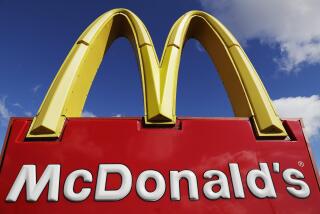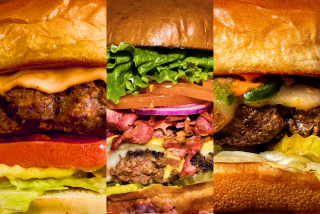Burger Business in Italy Begins to Sizzle
- Share via
ROME — After a slow start, fast food is eating away at Italian resistance to practically anything but pasta on the plate.
And while nobody’s hanging up their spaghetti colanders for good, many agree that burger outlets in Italy are hardly just a flash in the pan.
“We’re very sure” fast food is here to stay, said Stefano Secchi, marketing director for Burghy, an Italian hamburger chain. “I believe the number of fast foods will double in two years.”
Now we’re not talking thousands, or even hundreds, of restaurants--but even scores more is no small potatoes in a country where celebrities joined union leaders to dish out free pasta just 10 years ago to protest the arrival of McDonald’s off the Spanish Steps, a popular tourist spot in the center of Rome.
McDonald’s didn’t even venture into Italy before 1985--that’s 13 years after the French started putting away Big Macs along with their pommes de terre frites.
France had 384 McDonald’s by the end of August, compared to 28 in Italy, a neighbor with approximately the same population and similarly sacred culinary traditions.
“Italy was one of the last countries where McDonald’s were opened up because it didn’t have the flexibility required,” said Alessandra Di Montezemolo, a spokeswoman for the company in Italy.
*
Fast-food companies faced many obstacles when trying to open restaurants in Italy: sky-high rents in historic centers, layers of Italian bureaucracy and politically powerful labor unions.
In addition, up until 1985 Italy mostly didn’t permit part-time work or apprenticeships, which many fast-food chains depend on.
But much has changed in recent years, with the idea of fast-food restaurants becoming more accepted.
In 1987, Saverio Solimeo opened a McDonald’s in Bologna, the heart of Italy’s Red Belt, where labor unions traditionally were strong.
“Now things are changed. Unions are more willing to let you hire” part-timers, said Solimeo, a Roman who grew up in the United States.
Jacques Bahbout, an Egyptian-born Frenchman who runs four McDonald’s in Rome and is opening at least two more restaurants, says he employs 700 people and has a waiting list of 8,000.
While labor problems seem to be fading, some companies continue to run into bureaucratic nightmares. It took Bahbout nearly five years to open one of his locations.
Compared to those hurdles, adapting to Italians’ food habits was surprisingly the easiest part.
“Everyone thought we’d last six months or a year,” Solimeo said.
But with many city workers reluctant to brave traffic jams to go home for three-hour lunch breaks, alternatives to expensive and slow-serving trattorias have found their place.
Fast food is “no longer such a fad,” said Manola De Signore, a young Roman taking her aunt and uncle to lunch at Burghy, whose outdoor tables take in a view of the Pantheon. “It’s for the convenience, the time.”
A simple meal of pasta, meat and dessert in a modest Roman trattoria can easily run over $20 a head. A hamburger, fries, salad, cake and beer go for about half that at a fast-food restaurant.
At Bahbout’s restaurants, he’s introduced cold salads of pasta, rice or greens and added some familiar dishes such as insalata caprese, mozzarella and tomatoes drizzled with oil.
“I needed a kind of bridge between two cultures,” Bahbout said. But he believes Italians were ready for fast food all along.
“I know of no other country that has so many [coffee] bars and tramezzini,” the triangular-shaped, crustless sandwiches that millions of Italians eat every day for lunch.
“People eat on their feet. It was the hamburger aspect that was different.”
More to Read
Sign up for Essential California
The most important California stories and recommendations in your inbox every morning.
You may occasionally receive promotional content from the Los Angeles Times.













